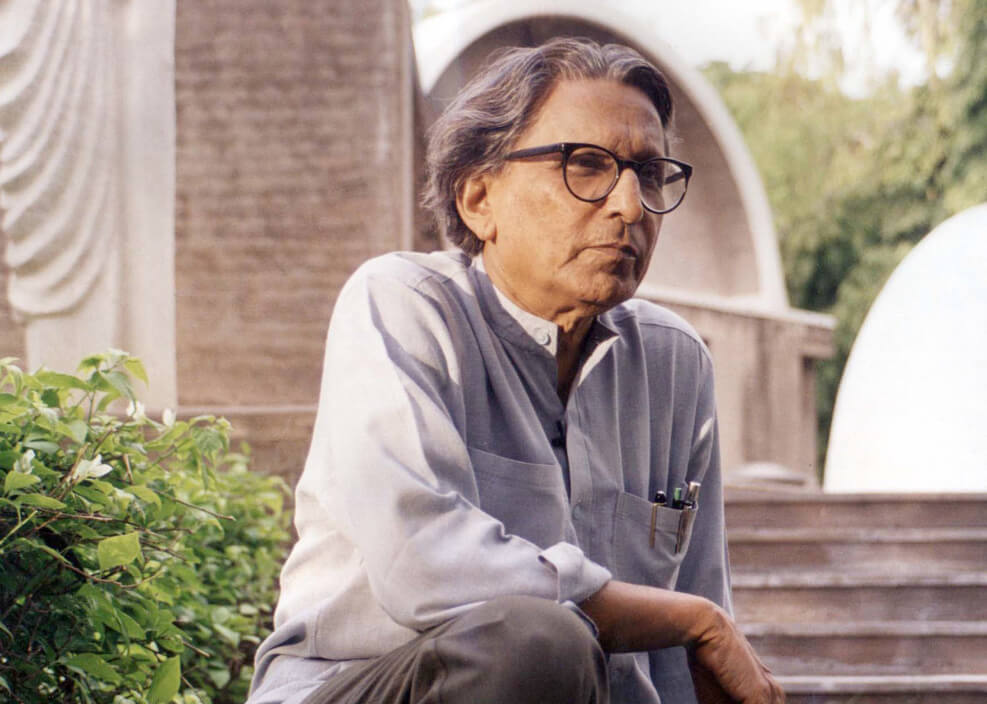[ad_1]
Balkrishna Vithaldas Doshi, India’s iconic architect, educator, and visionary, went gently into the world beyond at his home on January 24, 2023.
He was country’s first recipient of the illustrious Pritzker Architecture Prize (2018) and the second, after Charles Correa, to earn RIBA’s Royal Gold Medal, which he did in 2022. When I called him up to congratulate on the honor, he was his usual self-effacing, bantering self. I quipped jokingly, “Well, both the presenter [the late Queen Elizabeth] and the recipient will make a fine pair of nonagenarians!” He laughed heartily, “I will be the younger one!”

His impact on the country was further recognized just after his death, when, on India’s 74th Republic Day, he was posthumously awarded Padma Vibhushan, the nation’s second highest civilian honor. Noting Doshi’s passing, Prime Minister Narendra Modi also shared his condolences. “Dr BV Doshi ji was a brilliant architect and a remarkable institution builder. The coming generations will get glimpses of his greatness by admiring his rich work across India. His passing away is saddening. Condolences to his family and admirers. Om shanti,” the prime minister tweeted.
Doshi’s death continues the slow close of an era of post-Independence Indian architecture. Along with his colleagues Charles Correa, Achyut Kanvinde, Anant Raje, and Raj Rewal, he was one of the country’s top architects from that generation. (Thankfully, Rewal, 88 years old, is still with us.) These architects trained abroad in top institutions abroad and, impassioned by the excitement of participating in nation-building, came back home to establish their own practices.
Among this group, Doshi was unique in numerous ways. Not only had he interned at the office of Le Corbusier in Paris, he also later worked with Louis Kahn when he awarded the Indian Institute of Management at Ahmedabad; Doshi, with Raje, coordinated the project.

While in Paris, Doshi was the only Indian architect who worked on Corbusier’s Capitol Complex at Chandigarh. Later, he returned to be the on-site architect for the High Court and the two projects Corbusier was doing at Ahmedabad: Mill Owners Association building and the Shodan House.
In leading his own practice Sangath from a complex of his own design in Ahmedabad, Doshi worked on a vast and divergent array of projects. His key projects include: Shreyas Comprehensive School Campus (1963), Ahmedabad; Atira Peon Housing & Guest House (1958), Ahmedabad; the Institute of Indology (1959), Ahmedabad; the School of Architecture in Ahmedabad—renamed CEPT University in 2002—which focused on creating spaces that promoted collaborative learning; Indian Institute of Management in Bangalore (1992); Aranya low-cost housing (1989) in Indore, which won the Aga Khan Award for Architecture in 1995; and Amdavad ni Gufa (1994), a cave-like art gallery that exhibits the work of artist Maqbool Fida Husain.
Doshi’s greatest impact on Indian architecture was his multidisciplinary approach to architecture, which promoted dialogue and discourse and the experience of porosity within and through his buildings. He was inspired by timeless lessons embedded in the historic and traditional architecture of India, which he studied assiduously as to reinterpret their principles in his own works. His was a search for an Indian expression of modernism.
A great believer of bridging social inequalities, Doshi proposed and realized housing and townships across socioeconomic strata and encouraged people to improvise on and extend an architect’s formal design. A liberal at heart and full of humanism and empathy, he was constantly interested in reaching even the most workaday of his buildings’ end users. Still, Doshi’s most profound contributions came through his work as an educator and institution builder.

Upon hearing the news that he was selected for RIBA’s Royal Gold Medal last year, Doshi expressed tremendous joy at finally receiving the prize his guru Corbusier received in 1953.“The news of this award brings back memories of my time working with Le Corbusier in 1953 when he had just received the news of getting the Royal Gold Medal,” he shared in remarks.
On Doshi’s last visit to Chandigarh in October 2016, I had the unique opportunity of walking with him every morning for nearly two hours in the Capitol Complex. Like a perennial good teacher, he was passionately demystifying or highlighting some enigmas of Corbusier embedded in the architect’s mystical monuments. There was never a moment when a rare revelation was not unpeeled from the patina of the master’s concepts. Yet, for the then–89-year- old Doshi-ji, it was never tiresome.
During that visit, he delivered a spell-binding, two-hour slide lecture from the sculptural concrete oval-shaped podium in the “Trench of Consideration” in the sunken amphitheater, with the base of Corbusier’s Open Hand looming large overhead. The pin-drop silence of the 300-plus audience of architects, citizens, and administrators sitting in thrall of their city’s marvel of architectural ensemble, only to break into thunderous applause at the end, will always ring loud in my heart. There was no better architect than Balkrishna V. Doshi who deserved to speak from this historic pulpit.
Rajnish Wattas, former principal of the Chandigarh College of Architecture, is a noted author-critic.
[ad_2]
Source link
